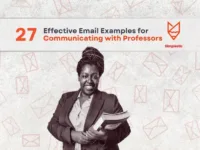How to End an Email to a Teacher | Ending an email to a teacher or a professor is an essential part of composing your message. It summarizes your communication’s tone and shows your respect and professionalism towards the recipient. Given the importance of academic relationships and communication, knowing how to appropriately conclude an email to your teacher can impact the reception of your message. This guide provides comprehensive insights, from choosing the right sign-off to the nuances of email etiquette in an academic setting.
End an Email to a Teacher on a Good Note
Emails to educators should reflect a level of formality and respect. The conclusion is not just a sign-off but a final opportunity to leave a positive impression. It’s essential to understand that how you end your email can reinforce the respect you carry for your instructor and reflect your professionalism.
How to End an Email to a Teacher | 25 Examples
Choosing the Right Sign-Off
The sign-off, or valediction, is a critical component of your email, serving as the closing remark before your name. It’s vital to select a sign-off that communicates respect and professionalism. Below are some commonly accepted sign-offs for emails to teachers or professors:
- Sincerely: Universally recognized as a professional and respectful sign-off. It’s suitable for first-time communications or more formal emails.
- Best regards: A warm yet appropriate choice for most communications with your teachers. It strikes a balance between formality and friendliness.
- Kind regards: Similar to “Best regards,” but adds a touch of kindness to your message, making it ideal for follow-up emails.
- Respectfully: This sign-off is decidedly formal and shows a deep level of respect. It’s particularly fitting if you’re addressing a teacher you don’t know well or discussing a serious subject.
- Thank you: Use this when you’re expressing gratitude, such as for feedback or assistance. It’s both polite and acknowledges the teacher’s effort.
How to End an Email to a Teacher | 25 Examples
Here are 25 examples of sign-offs that can be appropriately used when emailing a teacher or professor, depending on the context and nature of your relationship:
- Sincerely,
- Best regards,
- Kind regards,
- Warm regards,
- With appreciation,
- Respectfully,
- Many thanks,
- With gratitude,
- Thank you,
- Best wishes,
- Warmly,
- Cordially,
- Regards,
- With respect,
- Yours truly,
- Yours sincerely,
- Yours respectfully,
- In appreciation,
- In gratitude,
- Thank you for your consideration,
- With best wishes,
- Looking forward to your feedback,
- Appreciatively,
- With all due respect,
- With warm thanks,
Each of these sign-offs serves a different purpose and carries varying degrees of formality. Selecting the right one goes a long way in ensuring your email is received in the spirit you intended. Remember, your relationship and familiarity with the recipient can also guide your choice of sign-off.
How to End an Email to a Teacher | 18 Concluding Statements
Concluding Sentences Before Signing Off
Before your sign-off, a brief closing statement can be used to summarize your email, reiterate thanks, or express hope for a response. Here is a list of concluding sentences suitable for an email to a teacher. These can neatly wrap up the content while remaining respectful and considerate of the teacher’s expertise and time:
- Thank you for considering my request.
- I look forward to your feedback.”
- I appreciate your time and assistance.
- Thank you for your guidance and support.
- I appreciate your insights on this matter and look forward to your advice.
- Your feedback on this would be greatly valued.
- I am eager to hear your thoughts on my progress.
- Thank you for considering my request.
- I look forward to discussing this in more detail.
- Your assistance in this matter is greatly appreciated.
- I’m grateful for your help and understanding.
- Thank you for your time and attention.
- I hope to implement your suggestions effectively.
- Please let me know if there’s a convenient time to discuss this further.
- I appreciate any additional guidance you could provide.
- Thank you for your patience and support.
- I look forward to your valuable feedback.
- Thank you for your dedication to all your students, including myself.
Use these concluding sentences should help maintain a polite tone and express appreciation for your teacher’s efforts, which is usually appreciated in academic correspondence.
Note for Students | Including a Professional Signature
After your chosen sign-off, include a professional signature. It should consist of your full name, major or department (if applicable), and your year of study or student ID:
- Sincerely,
[Your Full Name]
[B.A. English Literature, Senior]
Student ID: ######
How to End an Email to a Teacher | Checklist
Email Etiquette Checklist
- Review Before Sending: Before you press “send,” ensure that your email is free from typos and grammatical errors. It should be well-structured and concise, retaining a tone of respect and politeness.
- Use a Professional Email Address: Your email address should reflect professionalism. Ideally, use your university or college provided email, or a professional personal email address.
- Subject Line: It should be informative and concise, providing a clear indication of the email’s content to your teacher.
- Timeliness: Consider the timing of your email. Avoid sending emails at odd hours, respecting your teacher’s personal time.
Ending an email to a teacher appropriately is more than selecting the right words; it’s about cultivating a culture of respect and professionalism. By thoughtfully choosing your sign-off, providing a signature, and adhering to the broader etiquette of email correspondence, you demonstrate not only your respect for your teacher but also your maturity and professionalism.
Emails are a significant aspect of academic communication, serving as a bridge between you and your educators. Whether you’re querying about an assignment, seeking feedback, or discussing class materials, the way you conclude your emails plays a crucial role in fostering positive relationships and communication channels within your academic journey.




